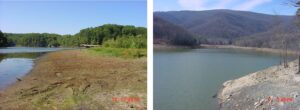You’ve no doubt heard this phrase, and recently in reference to our climatic conditions and state of our creeks and rivers. According to my semi-authoritative sources on the internet, bones are not really all that dry. Living bones have a lot of moisture in their squishy marrow and vessels; maybe 60% moisture is a fair approximation.
By way of example, the discharge last week of the nearby Rivanna River (according to the USGS gage) was running at 10 to 15% of the long-term mean value — 89 years of data to be precise. So, right now, the river is actually drier than a bone. I’ve seen old-timers suck more moisture out of a chicken bone than exists in our creeks right now.
And of course this is serious business for our farmers, water supplies, fire danger, trees and gardens, and, I must add, our collective temperament.

The Rivanna River last week as it flows alongside the City of Charlottesville. You can certainly see more of the bones of the river, as rocky bones and grass about as evident as actual water.
It led me to recollect the drought of 2002, which may still be the drought of record in these parts. At the time, I was the Water Resources Manager for Albemarle County, VA, and we were thinking more about floods leading up that historic drought. You see, it had only been a few years since we experienced the flood or record. But, in 2002, the climate pulled a fast one on us (or perhaps that would be a slow one).
The photos and documents below record just some of the sites and water conservation measures from that time.

The Mechums River in Albemarle County drains over 90 square miles and is a feeder streams to a major drinking water reservoir. In 2002, after several successive dry winters (the key time for groundwater recharge) the Mechums went dry that summer. The USGS gage showed zero stream flow for much of August and September of that year.

Left: The 2002 water emergency flyer did not mince words: What Will You Do When The Water is Gone? There was also a hotline that someone could call if they witnessed a violation of the restrictions, such as a neighbor watering their lawn. Restaurants were required to serve on paper plates and use disposable cutlery. It was not a good time for area car wash businesses. Right: The data underlying the 2002 drought was a combination of several years of declining precipitation during the dormant season as well as falling groundwater levels.

In the summer of 2002, you couldn’t slake your thirst at the County Office Building! The community was getting creative on ways to save water.
Citizens and businesses were getting creative about conserving water. My wife rigged up a siphon system from our upstairs bathroom shower (with the drain plug in place), out the second story window, and down to the persimmon and fig trees in the yard. This effort, among other citizen and business actions, made it into an article in the local community newspaper.
Some of the conservation efforts were sticky, meaning that their benefits endured even after it started raining again in October. The area water utilities gave away water-saving showerheads and provided rebates for the purchase of more efficient toilets. These house-by-house improvements meant that area water demand declined or remained steady even as the population grew (for a time, anyway).
All that said, the restaurants, carwashes, other businesses, and community as a whole had no complaints when the rains started up again and reservoir capacity was restored. However, one of the take-homes is that the community responded when asked to do so for the sake of mutual and collective benefit.
We have learned a thing or two in recent years about our capacity for collective action in the face of crisis. Sometimes that capacity coalesces into action and sometimes it fractures. The 2002 poster warned: What Will You Do When The Water Is Gone? How fortunate we are in this region to have the water, and that it actually running dry in our homes and communities is not something we contend with day-to-day or year-to-year. But that good fortune is now dependent on our collective capacity to cherish and conserve each drop of it.
David J. Hirschman, dave@hirschmanwater.com
July 23, 2024

